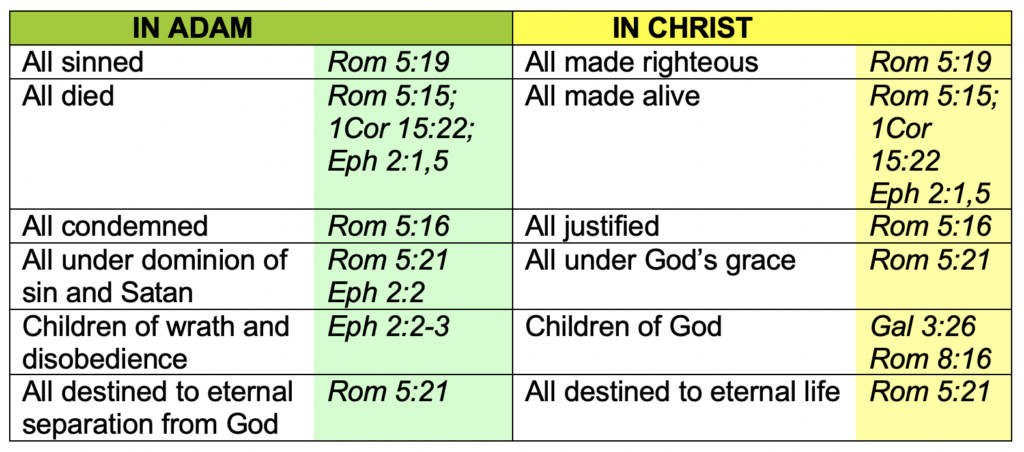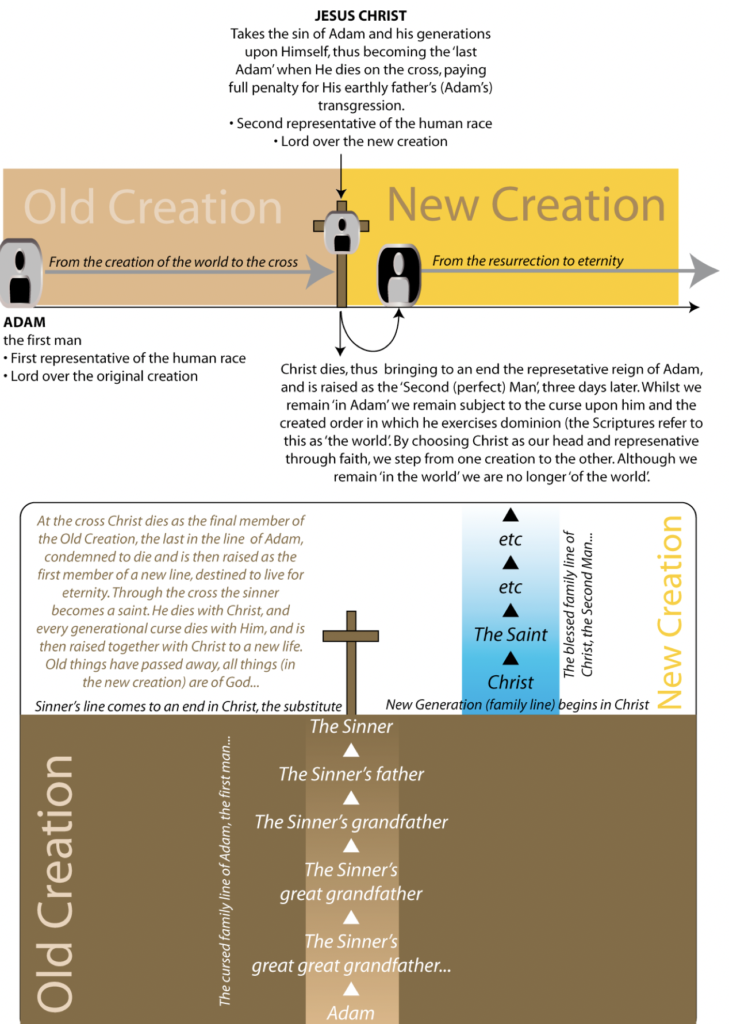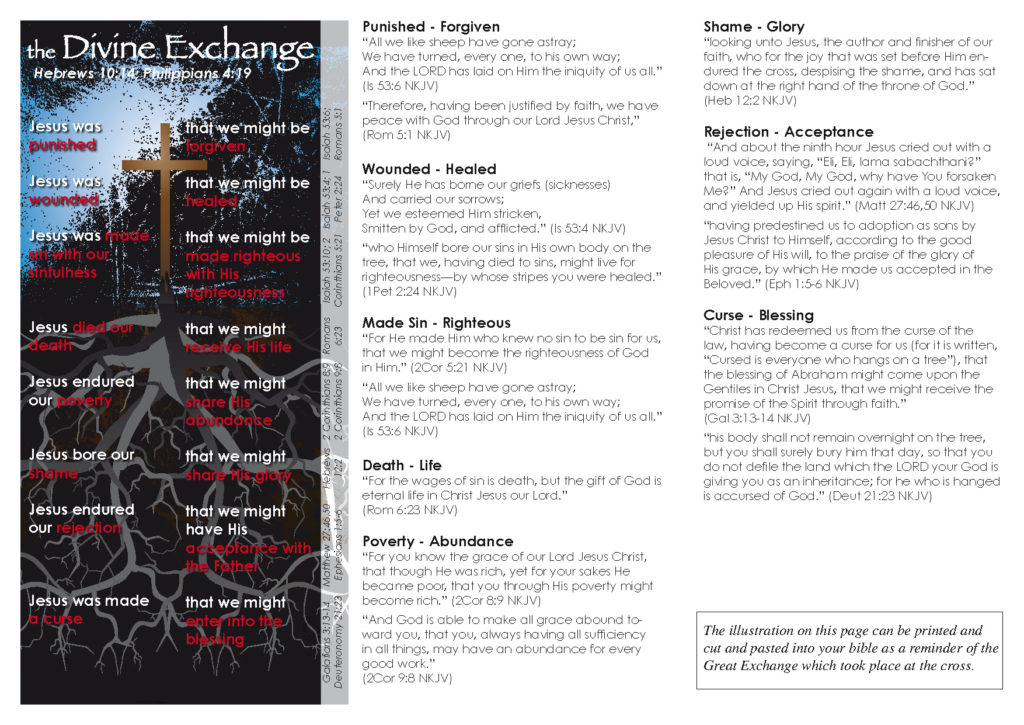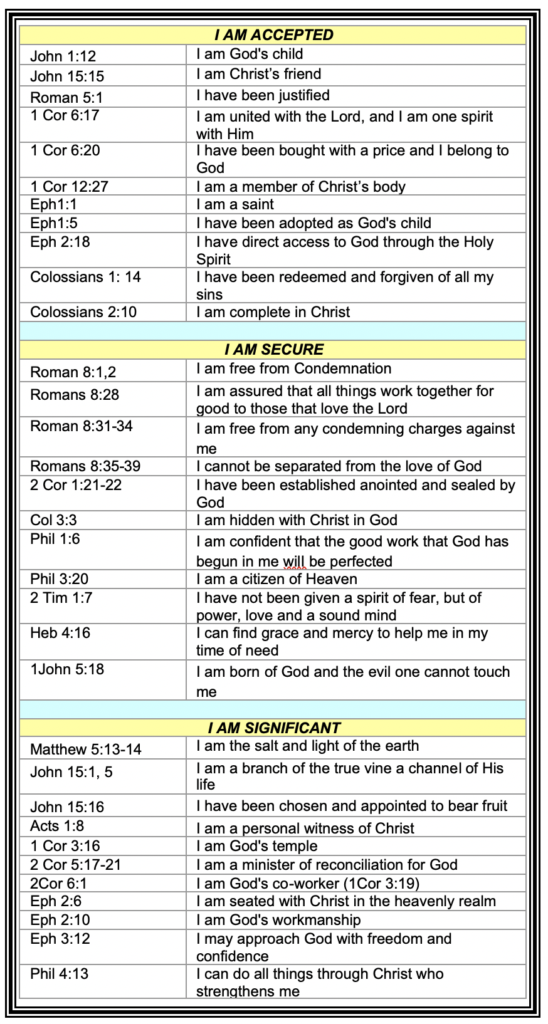A common expression in New Testament theology is the term ‘in Christ realities’. This is simply a term used to summarise the profound change brought about in the spirit of the born-again believer through re-generation. In exploring the truths therein we contrast the realities of what we ‘were’ prior to conversion to what we are now having believed in Christ for salvation.
Two Creations
In order to fully grasp the teachings concerning ‘in Christ realities’ it is important to restate the federal nature of Adam and of Christ as representatives of the human race.
The Bible speaks of two ‘creations’. The head of the first is Adam. It was delivered to him in the Garden of Eden when God placed it under his care and dominion (Gen 1:26-28). Unfortunately he proceeded to defer this authority to satan by choosing to trust and follow him (Luke 4:6; Rom 6:16). Essentially, Adam was the ‘god of this world’. When he handed his delegated authority to the devil, satan himself took Adam’s place. This is why the Scripture’s call the devil the ‘god of this world’ (2 Cor 4:4; 1 John 5:19).
The head of the second, or new creation, is Jesus Christ Himself. At the cross Jesus took back the authority which was forfeited by Adam.
“And Jesus came and spoke to them, saying, “All authority has been given to Me in heaven and on earth.” (Matt 28:18 NKJV)
Every individual therefore comes under the headship of Adam, described a being “in Adam”, or the headship of Christ, “in Christ”.
“in Adam” or “in Christ”
As the delegated authority over the original created world, Adam carried in himself the entire unborn human race. The implications of this fact are explored in previous sessions under the doctrine of ‘imputation’. This teaching states that Adam’s sin was ‘imputed’ or ‘accounted to’ his progeny. Effectively, if Adam obeyed, we obeyed, if Adam sinned, we sinned, with all the requisite consequences.
Paul therefore quite rightly concludes that “in Adam all died” (1 Cor 15:22). Fortunately however the story does not end there. Just as all “died” in the first man, all are “made alive” in the second.
We are raised to new life in the “second man”, Jesus Christ.
“But now Christ is risen from the dead, and has become the firstfruits of those who have fallen asleep. For since by man came death, by Man also came the resurrection of the dead…The first man was of the earth, made of dust; the second Man is the Lord from heaven.” (1Cor 15:20-21,47 NKJV)
The Scriptures continue to explain that just as we have borne the image of the earthly man, we shall ultimately bear the full image and likeness of the second, heavenly, man.
The Last Adam
In referring to Jesus Christ the Scriptures call Him not only the second perfect representative man, but also the “last Adam”.
Why the “last” Adam? Imputed to Christ on the cross of Calvary was the full penalty of sin, Christ took upon Himself the sins of every generation proceeding from Adam until the end of time, thus bringing to an end the cursed line of Adam’s reign and stewardship of the created order.
Jesus was, by substitution, the last in Adam’s line, comprising in Himself all the history and penalty of that genealogical line. Thus when He died the line came to end, and with it the curse it was under. Sin no longer has a authority over a dead man. The wages of sin in death (Romans 6:23), and once full payment has been made no further demands can rightfully be made. As our Substitute Christ therefore died as part of the cursed Adamic line, and with His death the line, and the curse, was cut off.
“Christ has redeemed us from the curse of the law, having become a curse for us (for it is written, “Cursed is everyone who hangs on a tree”),” (Galatians 3:13 NKJV)
Jesus Christ was then raised again from the dead, death being unable to hold someone without any personal debt of sin to pay, and took Adam’s place as the new ruler and steward of God’s created order.
Jesus Christ now has all authority in both Heaven and earth (Matthew 28:18). Acceptance of His Lordship bestows upon the believer all the benefits and status due to Christ Himself, including right standing with God, authority in the created world, victory of sin etc etc. Just as our first father Adam, sinned, and his sin was accounted to us, so now the righteousness of our new representative, Jesus Christ, is added to our account.
His authority is imputed to us, His victory becomes yours and mine.
This new potential, embodied in the risen Christ, is now available to all who believe. It is what the Bible calls a “new creation”. The old creation, under Adam’s fallen dominion (subject to sin and satan), died with Christ. Truly Christ was telling the cosmic truth when He made His final proclamation on the cross, “it is finished!”(John 19:30). With His glorious resurrection, a new creation proceeded.
The decision of each person therefore remains, God honouring entirely the free will of the individual; do we choose to remain under the dominion of satan in the old creation, which is corrupt and passing away (and in which those who dwell therein will pass away with it into eternal separation from God)? or do we through faith in Christ’s substitutionary death and resurrection, choose to enter the new creation ‘in Christ’.
The following table presents some of the facts pertaining to these contrasting realities:

We remain children of Adam’s disobedience, carrying his nature (Eph 2:2), living under the influence of satan (John 8:44), or through faith, we are born again (a second time, from above) and become ‘children of God’ (John 1:12-13).
The recurrent theme of personal transformation as a result of faith in Christ is pictured in many ways in the New Testament. These illustrations can help us understand the dramatic extent of this change, and the pains taken by the New Testament writers to underline the reality of this change:
Our translation from Adam to Christ is likened to:
Passing through a doorway
“I am the door. If anyone enters by Me, he will be saved, and will go in and out and find pasture.” (John 10:9 NKJV)
Through Christ we enter into the kingdom of God, we enter His sheepfold, and come under His care and leadership. In effect, we close the door firmly on our past, on Adam, and on satan and sin, and step into a new realm of existence.
A death and a birth
Romans 6:1-11; John 3:1-7
We died and were buried with Christ. Sin’s power over our lives went to the grave with us. We were then ‘born-again’ to newness of life. We were born-again into another family whose history and future are one of nobility and victory!
A death and a resurrection
“If then you were raised with Christ, seek those things which are above, where Christ is, sitting at the right hand of God. For you died, and your life is hidden with Christ in God.” (Col 3:1,3 NKJV)
We died with Christ – the old you is no longer, and we were raised as a brand new creation with Christ. It is no longer us that live, but Christ who now lives in us (Galatians 2:20). Every legal claim upon our lives because of Adam’s sin is annulled with our death, and we are raised as free men and women, at liberty to follow whom we will.
A Translation (Transition, transportation, transfer, conveyance) from one place or kingdom to another
“He has delivered us from the power of darkness and conveyed us into the kingdom of the Son of His love,” (Col 1:13 NKJV)
In Christ we were lifted from under the despotic rule of satan and sin, and carried across into the Kingdom of God’s loving Son, Jesus Christ. We change our location. We change our position.
A change of citizenship
Hebrews 11:14-16; Philippians 3:20
“For our citizenship is in heaven, from which we also eagerly wait for the Savior, the Lord Jesus Christ,” (Phil 3:20 NKJV)
We have officially changed our citizenship from a member of Adam’s race and household, worldly citizenship, to citizenship of a heavenly country and household. We are fellow citizens with all the saints (Eph 2:19), with all the attendant benefits such citizenship bestows. During our remaining time as pilgrims in the earth, we are ambassadors of this glorious new Kingdom of which we are now a part (2 Cor 5:20).
A transfer of authority
“to open their eyes, in order to turn them from darkness to light, and from the power (authority) of Satan to God, that they may receive forgiveness of sins and an inheritance among those who are sanctified by faith in Me.’” (Acts 26:18 NKJV)
In crossing from Adam to Christ we change the authority over our lives. Adam chose to place himself in subjection to satan when he yielded to him in the garden of Eden (Genesis 3; Romans 6:6; 2Peter 2:19).
Jesus overcame satan in the temptation (Matthew 4; Luke 4), and we are now under His gracious rule and protection.
A divorce (final separation) and remarriage
Romans 7:1-4; 1 Corinthians 7:39
On the cross we were legally freed from the obligations of marriage to the law and to the world in Adam, and with the resurrection we were recreated, a virginal pure bride at liberty to marry whom we will. We chose to marry our risen heavenly bridegroom, Jesus Christ.
Our original husband, Adam, died with Christ (the last Adam), thus bringing any covenantal obligation and tie to an end. Christ was then raised from the dead, the firstfruits of the new creation and we, now a free woman, married Him!
A putting off the old – and a putting on the new
Colossians 3:8-14
At the cross we removed the filthy garments of sin and rebellion, nailing who we were to the cross forever. We then clothe ourselves with a new garment, Christ Himself.
Going from darkness to light
Acts 26:18; Ephesians 5:8; John 1:5; Matthew 5:14
We were not only living in darkness, we were darkness. When we stepped into Christ’s light, we became light. As dramatic as the difference between darkness and light, so is the change that takes place when we come to Christ. Darkness and light can never mix, and light will always overcome darkness. Today we are the light of the world in Christ Jesus!
From slavery to sonship
John 8:34; 1:12; Rom 6:18,22; 1John 3:1
We were slaves to sin, and to our own lusts, but Christ purchased our redemption and set us as full fledged sons and daughters in the household of God.
A losing and a finding
Matthew 16:25; Mark 8:35; Luke 9:24;17:33
“For whoever desires to save his life will lose it, but whoever loses his life for My sake will find it.” (Matt 16:25 NKJV)
Our old life in Adam is what we lose in Christ (and it is amazing how aggressively we sometimes seek to preserve it!), only to discover that on the other side of loss is great and awesome gain, a new life in Christ!
Other pictures also include: From condemnation to acquittal, a metamorphosis, crossing over into the land of promise, crossing from law and slavery to grace and freedom, moving from childhood to maturity, crossing from a desert to a land of rest and promise etc…

Entrance into the new creation
The Scriptures tell us that we must be born again (from above).
“Jesus answered and said to him, “Most assuredly, I say to you, unless one is born again, he cannot see the kingdom of God.”
Nicodemus said to Him, “How can a man be born when he is old? Can he enter a second time into his mother’s womb and be born?”
Jesus answered, “Most assuredly, I say to you, unless one is born of water and the Spirit, he cannot enter the kingdom of God. That which is born of the flesh is flesh, and that which is born of the Spirit is spirit. Do not marvel that I said to you, “You must be born again.’” (John 3:3-7 NKJV)
This is a spiritual birth, enabling us to see and enter the kingdom of God which exists in the spiritual world.
We are born again (regenerated) when:
1. The seed of God’s word enters the heart. 1Peter 1:23
2. We believe in our heart that Jesus died for our sins and was raised from the dead. Romans 10:9
3. We confess with our mouth that Jesus is Lord. Romans 10:9
The Scriptures declare that as a result we will be ‘saved’ or ‘delivered’. Immediately we are delivered from the dominion of darkness (in Adam) and translated into the kingdom of God (in Christ):
“He has delivered us from the power of darkness and conveyed us into the kingdom of the Son of His love,” (Col 1:13 NKJV)
We are transferred from one creation, under the influence of satan, ‘the god of this world’ (2 Cor 4:4) into the kingdom of God and the new creation.
“to open their eyes, in order to turn them from darkness to light, and from the power of Satan to God, that they may receive forgiveness of sins and an inheritance among those who are sanctified by faith in Me.’” (Acts 26:18 NKJV)
Paul describes this redemption in 2 Corinthians 5:17-18:
“Therefore if any person is [ingrafted] in Christ (the Messiah) he is a new creation (a new creature altogether); the old [previous moral and spiritual condition] has passed away. Behold, the fresh and new has come! But all things are from God, Who through Jesus Christ reconciled us to Himself [received us into favor, brought us into harmony with Himself] and gave to us the ministry of reconciliation [that by word and deed we might aim to bring others into harmony with Him].” (2Cor 5:17-18 AMPLIFIED)
Paul here uses language that describes a new species of being that never existed before. The new creation is not the old creation with religious dressing, or a new improved version, but an entirely new creation altogether!
As original as the first creation was, with its overseer Adam, a ‘living soul’, (1 Cor 15:45), so is the new creation under its overseer and ruler, Jesus Christ, the ‘life-giving spirit’ (1 Cor 15:45).
Jesus Christ Himself, in His resurrected form, is the firstfruit of the population of the world to come (an expression used in Hebrews 6:5 to describe the new creation):
“But now Christ is risen from the dead, and has become the firstfruits of those who have fallen asleep…But each one in his own order: Christ the firstfruits, afterward those who are Christ’s at His coming.” (1Cor 15:20,23 NKJV)
It is of this world to come that we are now citizens. We are in this present world, but we are of this new world described as the new creation:
“They are not of the world, just as I am not of the world.” (John 17:16 NKJV)
The Divine Exchange of the Cross
An exchange took place at Calvary. Willmington describes this exchange in his Guide to the Bible as follows;
“The Son of God became the son of man, that the sons of men might become the sons of God.”
Another respected Bible teacher, Derek Prince (1915-2003) outlines some of the implications of this exchange in his aptly named booklet, “The Divine Exchange”:
“Here is the true meaning and purpose of the Cross. On it a divinely ordained exchange took place. First, Jesus endured in our place all the evil consequences that were due by divine justice to our iniquity. Now, in exchange, God offers us all the good that was due to the sinless obedience of Jesus.
Stated more briefly, the evil due to us came upon Jesus, that, in return, the good due to Jesus might be offered to us. God is able to offer this to us without compromising His own eternal justice, because Jesus has already endured on our behalf all the just punishment due to our iniquities.
All of this proceeds solely out of the unfathomable grace of God, and it is received solely by faith. There is no logical explanation in terms of cause and effect. None of us has ever done anything to deserve such an offer, and none of us can ever do anything to earn it.
Scripture reveals many different aspects of the exchange, and many different areas in which it applies. In each case, however, the same principle holds good:
“the evil came upon Jesus that the corresponding good might be offered to us.””
The Divine Exchange, Derek Prince

We are who we are, not what we do
There is a profound difference between “who” we are, and “what” we do. Too often we tend to define ourselves, and others, according to our function rather than by our personhood. In answer to the question, “Who are you?” we reply, “a plumber” or “a pastor”, “so-and-so’s husband or wife” and so on.
Our job description, however high or lowly, does not define us, nor is it where we derive our significance. It is in our relationship to the eternal, unchanging reality that our stability and significance comes; directly from our intimate family relationship with God.
Paul the Apostle understood this very well, almost always in his letters to the churches first laying a doctrinal understanding of “who” we are in Christ, before proceeding in the latter sections to outline “how” we should act in the light of the preceding truths. Essentially we ‘do’ because we ‘are’, not the other way around. We are not holy because we act holy, we act holy because we ARE holy! Our righteous acts proceed from our righteous nature, our righteous nature is not the result of our righteous acts.
It is our identity ‘in Christ’ that is the source and wellspring of Christlike character and Christlike behaviour. When we begin to understand ‘who we are’ we will begin to act accordingly.
John, not surprisingly, also displays a profound comprehension of these principles. In his gospel account he does not identify himself according to his calling or function in the body of Christ, but simply as “the disciple who Jesus loves” (John 21:20,24).
Who are you? “I am the one Jesus loves”. His identity was drawn from and defined by the love relationship he shared with the Father and the Son. The same is true of you and I. Regardless of whether you are a pastor, a king or a beggar, you are “the beloved”:
“Beloved, now we are children of God; and it has not yet been revealed what we shall be, but we know that when He is revealed, we shall be like Him, for we shall see Him as He is.” (1John 3:2 NKJV)
“Therefore, as the elect of God, holy and beloved, put on tender mercies, kindness, humility, meekness, longsuffering;” (Col 3:12 NKJV)
Having so often been defined by so many other things; the clothes we wear, the job we do, our family background, economic status, race, religion etc; it is important that we enter into a conscious process whereby we renew our mind to this new reality of who we REALLY ARE ‘in Christ’. Again we stress we are not trying to become something. We do not need to strive to be in Christ, we are in Christ. Many Christians are seeking to ‘die’ to certain things in their lives, and there is no shame in desiring holiness etc, but the avenue there is not by our efforts. It is through faith in the effectual work of the atonement at Calvary. Based upon the fact of Christ’s death and resurrection, we are encouraged to reckon ourselves already dead to sin, and alive unto God, on the basis of these historical facts and the spiritual results they obtained!
“Likewise you also, reckon yourselves to be dead indeed to sin, but alive to God in Christ Jesus our Lord.” (Rom 6:11 NKJV)
Our feelings and experience will follow our faith! If we believe that perfection comes as a result of perfect conduct, our experience will be like the one Paul describes in Romans chapter 7. On the other hand, if we accept the free gift that comes through Jesus Christ, the law of the Spirit of life in Christ Jesus will establish us in a life of gracious victory (as described in Romans chapter 8!).
On the pages that follow we include a table adapted from Neil T Anderson’s excellent book, “Victory over the Darkness” profiling the true identity of the regenerated believer in Christ:

